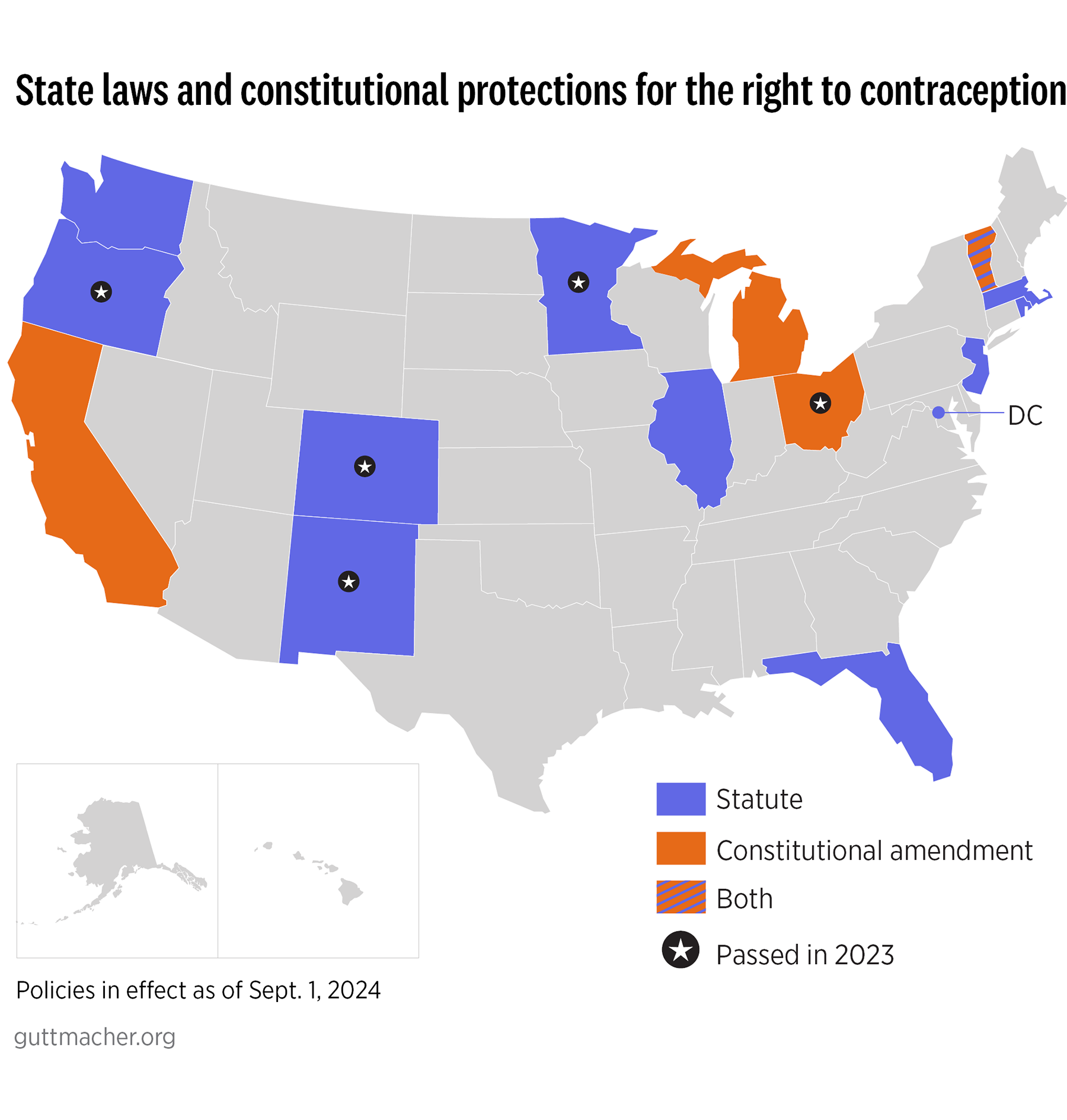Contraception in the United States is recognized as an essential component of health care and a fundamental right that is widely supported and has been upheld by policymakers and courts for decades. The US Supreme Court established a right for married couples to use contraceptives in 1965 and expanded that right in 1972 to single people, further emphasizing the value and necessity of contraceptive access for an individual’s health and autonomy (see timeline). Public policies like the Title X national family planning program and the Affordable Care Act (ACA) help make the full range of contraceptive methods affordable for many people, and nearly all Americans support the use of contraception. And yet, in the 2022 Dobbs v. Jackson Women’s Health Organization decision overturning Roe v. Wade, Supreme Court Justice Clarence Thomas explicitly called into question the Court’s 1965 decision in Griswold v. Connecticut. Policymakers at both the federal and state levels have taken that threat seriously and, in response, have introduced legislation protecting the right to contraception, as this fact sheet lays out.
The right to contraception is a cornerstone of person-centered and equitable health care. Contraceptive use allows people to control when and whether to become pregnant and helps address many medical conditions. Policymakers must act to support bodily autonomy, uphold gender and health equity, and affirm individuals’ ability to make informed decisions about their reproductive health, including by upholding the right to contraception.
Major US judicial and legislative actions on contraceptive access since the 1960s | ||
1965Griswold v. Connecticut | • | US Supreme Court ruled in favor of use of contraceptives by married couples |
1970Title X of Public Health Service Act enacted | • | Established a federal grant program to fund family planning clinics and provide comprehensive family planning services to low-income and uninsured individuals |
1972Eisenstadt v. Baird | • | US Supreme Court ruled in favor of distribution of contraceptives to unmarried individuals |
2010Affordable Care Act enacted | • | Required most private health insurance plans to cover contraceptive services and supplies without cost sharing |
2022Right to Contraception Act (HB 8373) | • | Legislation introduced and passed in US House to guarantee the federal right to contraceptive products, services and information |
2024Right to Contraception Act (S 4381) | • | Legislation introduced in US Senate to guarantee the federal right to contraceptive products, services and information |
Right to Contraception at the Federal Level
The Right to Contraception Act was first introduced in Congress in July 2022, shortly after the Supreme Court’s Dobbs decision was issued.
The legislation would establish individuals’ right to have access to all methods of contraception, including pills (both prescription and over the counter), implants and other devices, and sterilization. This legislation would prohibit any local, state or federal governmental entity from limiting or infringing on these rights with laws that single out or impede provision of or access to contraceptives or related information or services. In addition, the federal government could not block individuals from helping others obtain contraceptives. Taking these steps would ensure that access to contraception remains protected and universally available.
The Right to Contraception Act passed in the US House of Representatives in July 2022 with a party-line vote. In June 2024, consideration of the Senate version was blocked by a vote of 51 to 39, short of the 60 votes needed to defeat a filibuster and move the bill forward.
Right to Contraception at the State Level
While some states had the right to contraception in place before 2022, most states that have enshrined protections for contraception by statute, and all states that have included it in their constitution, did so after the Dobbs decision.
- Eleven states and the District of Columbia have laws explicitly protecting the right to contraception: Colorado, Florida, Illinois, Massachusetts, Minnesota, New Jersey, New Mexico, Oregon, Rhode Island, Vermont and Washington.
- Colorado’s statute is unique in that it ensures that minors can consent to receiving contraceptive information or supplies from a health care provider.
- Four states—California, Michigan, Ohio and Vermont—protect the right to contraception in their constitution under the broader scope of reproductive freedom.
- Michigan, for example, protects a wide variety of reproductive health care needs, including contraception, prenatal and postpartum care, miscarriage management, abortion and fertility treatment.
- Vermont has a general right to reproductive autonomy in its constitution, as well as a law specifically naming the right to contraception and sterilization.
Next Steps to Broaden Contraceptive Access
Securing the right to contraception is just one step toward securing and improving contraceptive access for all. A host of other policies must be considered, including enforcing the ACA’s contraceptive coverage requirements and ensuring that all health plans and programs meet the ACA’s standard of providing access to all methods without cost sharing, broadening access to contraceptives via pharmacies and telehealth options, and increasing funding for sexual and reproductive health care programs that support access for people with low incomes.
